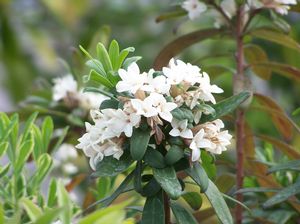View All Plants :: View All ARID LAND PLANTS :: View All DECIDUOUS SHRUBS
Daphne x transatlantica 'Eternal Fragrance'
Daphne
Plant Type:
ARID LAND PLANTSDaphne x transatlantica 'Eternal Fragrance' (PP 18.361, unlicensed propagation prohibited)(ex: John Bieber) – This beauty comes from the capable hands of Robin White, formerly of Blackthorn Nursery in England. The parentage is D. caucasica x collina. It equals D. x transatlantica 'Jim's Pride' in habit and vigor but with larger appearing flower clusters – the number of flowers increased by the fact that they emerge from axils as well as terminally. As with 'Jim's Pride', Its foliage, too, is improved, a glossier deep emerald green. 'Eternal Fragrance' blooms freely during the growing season on a well-established shrub – over its very handsome foil of green leaves. The beautiful pastel flowers may display more of a pink flush in the open florets than 'Jim's Pride' but the flowers soon become pure pristine white. We thank Robin White through PlantHaven in California for allowing us to produce a limited number of this remarkable introduction annually. Site in full sun planted in draining soil. Our x transatlantica cultivars are perfectly content in our xeric garden in which we've mixed some organic matter at the root zones.
For more information see Daphne x transatlantica 'Eternal Fragrance'
For a fun read see Daphne
More About Daphne x transatlantica 'Eternal Fragrance'
- Repeat Flowering
- Delicious Scent
- An Improved 'Jim's Pride'
Characteristics and Attributes for Daphne x transatlantica 'Eternal Fragrance'
Season of Interest (Flowering)
- Spring / Summer / into Autumn
Season of Interest (Foliage)
- Spring / Summer / Autumn
Nature Attraction
- Deer Resistant
Light
- Full Sun
Attributes
- Labyrinth
- Border
- Shrub Border
- Drought Tolerant
- Hedge
- Fragrant
- Foundation
- Specimen
- Rock Garden
Growth Rate in the Garden
- Medium
Soil
- Humus Laden
- Average
- Sandy
- Calcareous
- Draining
- Scrabbled
Origins
- Garden Origin
Propagated By
- Cutting Grown
Genus Overview: Daphne
Daphnes are shrubby members of Thymelaeaceae. Many have thrived in our xeric garden which provides a deep root run, good drainage with no extra water during droughts. We add dolomitic limestone to the planting holes when initially interring them. Most have fragrance which is heavenly, perfuming the air near where they bloom. We have observed those that flower or rebloom in summer draw hummingbirds.
For all the discussion about their finicky personalities we have found them mostly quite easy to please in the ground though they, as a group, are largely not happy in containers for long; in containers death visits frequently - especially the yearlings - and it is as annoying as frustrating! As my good friend, Jonathan Lehrer, has told me on occasion, “Daphnes will never be a mainstream shrub because even the easy ones will up and die suddenly for no apparent reason.” My feeling is nothing goes on living forever; for all of their remarkable qualities they are worth growing for as long as they choose to be around! Certainly, the hybrids (x burkwoodii and x transatlantica) exhibit exceptional hybrid vigor, strength and ease of establishment.
Snow loads in the north can be an issue on taller growers, therefore, I suggest pruning older plants after flowering to ensure stouter, bushier shrubs that may better counteract weighty winter precipitation. After pruning they recover beautifully and quickly. Also, all that flower in summer are attractive to hummingbirds. Most of our selections come to us gratis from John Bieber who lives on Long Island, longtime lover of all things Daphne. Most of our Daphnes are cutting grown. There are exceptions including D. alpina which has been completely resistant from stem cuttings; these will be seed grown when we do have them available which may be infrequently!


